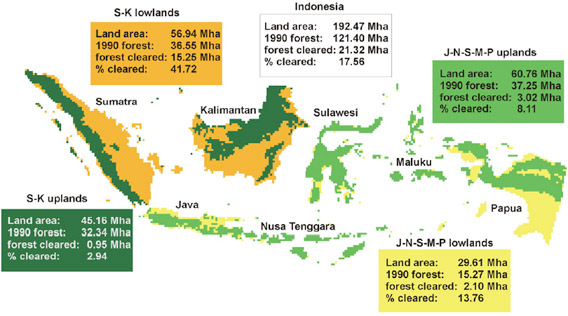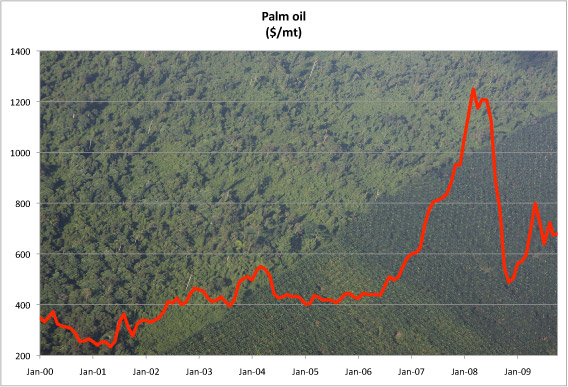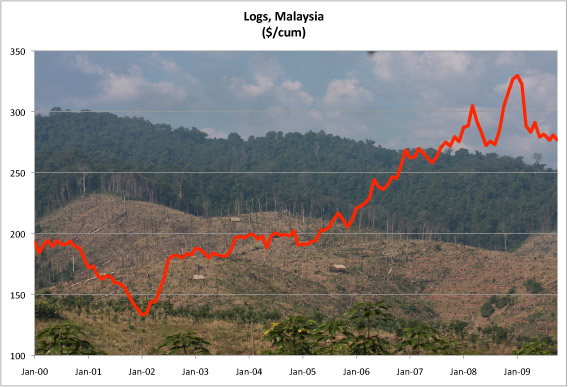Forty percent of lowland forests in Sumatra and Kalimantan (Indonesian Borneo) were cleared from 1990 to 2005, reports a high resolution assessment of land cover change in Indonesia.
The research, conducted by Matthew Hansen of South Dakota State University, and colleagues, found that Indonesia lost 21.35 million hectares (82,400 square miles) of forest during the period. Deforestation peaked in the 1990-2000 period (averaging 1.78 million hectares per year) before plunging around the turn of the century. Forest clearing has since crept up on a year-by-year basis, reaching 1 million hectares in 2005, but at 0.71 million hectares per year for the 2000-2005 period, remain below the 1990s rate.
Seventy percent of deforestation was concentrated in Sumatra and Borneo, the only islands that still house native orangutan populations.

The assessment is based on targeted sampling of remote sensing data that the authors say provides better accuracy than estimates from the U.N. Food and Agriculture Organization (FAO), the conventional source for forest cover estimates. FAO figures are based on satellite imagery and self-reported data from countries but have been widely criticized.
Hansen and colleagues last year released a global estimate for deforestation based on their targeted sampling methodology. They reported that 27.2 million hectares (105,000 square miles) of tropical rainforest were cleared from 2000 to 2005, an area representing 2.36 percent of global tropical forest cover. Brazil accounted for 48 percent of tropical deforestation, followed by Indonesia (13 percent).

Estimates of national and sub-national forest cover extent and loss. S-K stands for the combined Sumatra and Kalimantan island
groups. J-N-S-M-P stands for the combined Java, Nusa Tenggara, Sulawesi, Maluku and Papua island groups. Image courtesy of Hansen et. al. 2009.
Deforestation in Indonesia is principally caused by logging and conversion to agriculture and plantations. The palm oil and pulp and paper industries have emerged as major new drivers of forest clearance over the past 20 years.

Palm oil prices ($US/metric ton), Jan 2000-Oct 2009, based on World Bank data.

Meranti timber prices ($US/cubic meter), Jan 2000-Oct 2009, based on World Bank data.
CITATION: Matthew C Hansen, Stephen V Stehman, Peter V Potapov, Belinda Arunarwati, Fred Stolle and Kyle Pittman (2009). Quantifying changes in the rates of forest clearing in Indonesia from 1990 to 2005 using remotely sensed data sets. ENVIRONMENTAL RESEARCH LETTERS. Online at stacks.iop.org/ERL/4/034001
Related articles
Indonesia: emissions to rise 50% by 2030, 3rd largest GHG emitter
(09/22/2009) A report released by the Indonesian government shows the country is the world’s third largest greenhouse gas emitter, largely as a result of the destruction of rainforests and carbon-dense peatlands. Indonesia accounts for 8 percent of global carbon dioxide emissions.
New fire record for Borneo, Sumatra shows dramatic increase in rainforest destruction

(02/22/2009) Destruction of rainforests and peatlands is making Indonesia more susceptible to devastating forest fires, especially in dry el Niño years, report researchers writing in the journal Nature Geoscience. Constructing a record of fires dating back to 1960 for Sumatra and Kalimantan (on the island of Borneo) using airport visibility records to measure aerosols or “haze” prior to the availability of satellite data, Robert Field of the University of Toronto and colleagues found that the intensity and scale of fires has increased substantially in Indonesia since the early 1990s, coinciding with rapid expansion of oil palm plantations and industrial logging.
Rainforest destruction becomes industry-driven, concentrated geographically
(06/30/2008) New analysis of global deforestation reveals that the bulk of tropical forest loss is occurring in a small number of countries. The research — published in the journal Proceedings of the National Academy of Sciences (PNAS) — shows that Brazil accounts for nearly half of global deforestation, nearly four times that of the next highest country, Indonesia, which makes up about an eighth of worldwide forest clearing.
Half of oil palm expansion in Malaysia, Indonesia occurs at expense of forests
(05/20/2008) More than half of the oil palm expansion between 1990 and 2005 Malaysia and Indonesia occurred at expense of forests, reports a new analysis published in the journal conservation Letters. Analyzing data from the United Nations Food and Agriculture Organization, Lian Pin Koh and David S. Wilcove of Princeton University found that 55-59 percent of oil palm expansion in Malaysia and at least 56 percent of that in Indonesia occurred at the expense of forests. Given that oil palm plantations are biologically impoverished relative to primary and secondary forests, the researchers recommend restricting future expansion to pre-existing cropland and degraded habitats.